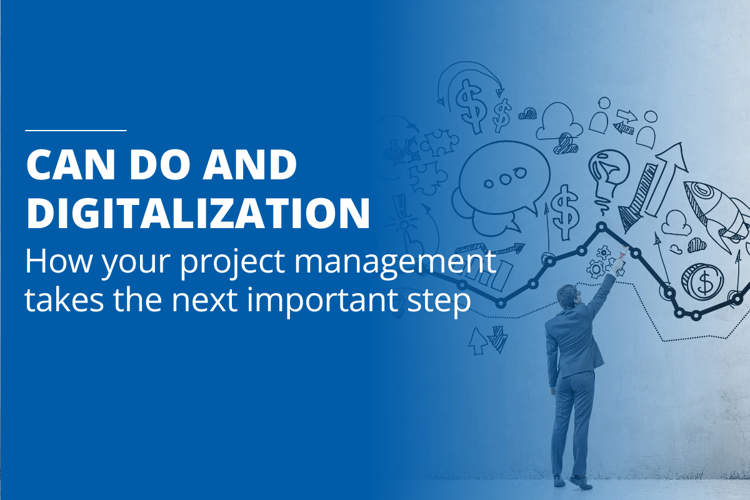In view of the digitization of industry and services, it is surprising - and yet: The majority of project managers who are interested in Can Do have so far mastered their daily project routine without project management or project planning software. And quite a few project managers are still doing this today: managing projects - without a project planning tool, instead manually, with static tables and on demand. We show why this cannot work in the long run and where the advantages of a project planning software lie.

A spreadsheet is not a project plan tool
"Excel® is the second-best solution for almost all tasks": With this assessment of the project planning software in many German companies, Can Do CEO Thomas Schlereth sums up the usage behavior of the spreadsheet. For good reason, it is the standard for typical tasks that can be presented in tabular form; but because it is so powerful and versatile, Excel® is also used in other areas for which it is basically not intended at all - for example, in project planning / project management. Because they already know the tool, project managers stick with it and either learn to live with its shortcomings as project management software or develop appropriate workarounds. The quick benefit at the beginning becomes a detriment at the latest when it comes to cross-project resource planning. The number of users for the Excel file increases and with it the complexity.
This costs time as well as nerves and leads to the fact that the project management is not relieved but has to deal with the wrong "project planner software".
Can Do, on the other hand, as a representative of dedicated project planning software / PM software, supports the PMO or the individual project managers with tools that make their daily project business easier and, above all, get a grip on complex resource management. To make clear the advantages of modern project management software compared to project management by spreadsheets, we list some of the most important differences. And we would be happy if we can help to initiate one or the other change in project management ...
1. Project Planning Software grows with you
Wachstum ist nicht nur ein Ziel – es ist die logische Konsequenz für jedes erfolgreiche Unternehmen. Mehr Mitarbeitende, mehr Projekte, mehr Planung und Controlling: Die Abteilung, die Wachstum mit am ehesten trägt und vorantreibt, ist das Projektmanagement. Aber wie kann das PMO, können die Projektmanager:innen dieses Wachstum umsetzen, wenn ihre Projektplaner Software eine Tabellenkalkulations-Software ist? Zu Beginn natürlich mit noch mehr Zeilen, noch mehr Spalten und vielleicht auch weiteren Arbeitsblättern. Spätestens an einem vitalen Multiprojektmanagement mit großem Portfolio werden die Grenzen dieses Vorgehens aber sehr schnell klar.
Ein Projektplan Tool bzw. eine Projektmanagement-Software dagegen wächst mit ihren Aufgaben, ohne dass Sie die Übersicht verlieren. So kennt Can Do keine mengenmäßigen Grenzen, seien es Projekte, Portfolios, Ressourcen oder Arbeitspakete.
2. Project Planner Software is agile and flexible
Notwithstanding: As long as it is about the pure planning of a handful of projects with fixed milestones, it is quite possible to map them with a spreadsheet. In such a case, Excel® , for example, serves primarily to provide a clear format. But what if you are dealing with agile projects - which is rather the standard? When milestones shift, projects influence each other or even slow each other down, employees change between teams - or most complex: When employees are deployed in several projects in parallel? Then grueling manual work is called for to bring the table back into line with reality. Over the course of time, we have met PMOs and project managers who could spend less time on the actual project planning than they needed to clean up the spreadsheets and bring them back into line with the actual project status. So the spreadsheet software did not become a project planning software as planned - but a time-delayed digital documentation of the project progress.
This is different if you use a specialized project planning software: Can Do dynamically adapts to new circumstances. When teams change or milestones shift, Can Do shows the impact - in real-time and even in multi-project portfolios. What's more, Can Do's artificial intelligence calculates thousands of possible developments and makes concrete recommendations for action so that the project doesn't get into trouble after all and the goals can be met. And finally, the AI is also used to simulate "what if" scenarios and plan appropriate reactions before they occur.
3. A Project Plan tool is trustworthy
Admittedly, this sounds a bit presumptuous - but it is true: Anyone who can use spreadsheet software can fill in a table. This circumstance can have an impact on the acceptance of project planning or project management: For the team members, milestones and project goals often appear arbitrary - just more or less thoughtfully filled in boxes in a spreadsheet that can just as easily be moved around again. With software project management or PM software like Can Do, the issues of trustworthiness, acceptance and transparency are quite different: There, goals, milestones or team distributions follow a calculation. They are created and distributed on the basis of comprehensible, objective facts and data. As project management software, Can Do even goes a few steps further: teams are distributed using the proprietary Watermodel® algorithm, and milestones or entire project progressions are continuously redefined in real time by the Can Do AI. This neutrality, which is inherent in a project plan tool (a project management software), cannot be achieved by a spreadsheet populated "by hand". Teams and employees will always consider the results and forecasts of a project plan tool to be fairer, more realistic and more trustworthy.
4. A Software Project Management can be connected
A table is a table is a table: it stands on its own, has a self-sufficient expressiveness and can hardly get in touch with any other software. This is perhaps irrelevant for smaller project management tasks - but as projects become more complex, it becomes an ever-increasing burden that table sheets can only be filled in and evaluated manually. The situation is different if you use project management software (software project administration): This usually has integrations or interfaces. This is also true for the project planning software Can Do: For example, you can automatically integrate the project team software Jira® with our own migrator, use interfaces to SAP® - and even output evaluations for the stakeholders as Excel® sheets.
5. This Project Planning Software is oriented to people
A spreadsheet is always also an abstraction tool: Processes in the company, no matter what kind, are treated and evaluated as numbers or diagrams. Even the resources themselves, the employees, which are so important for your projects, become a number and a calculated variable. The Project Plan Toll (PM software) Can Do uses its AI here to approach resource management from its human side. So we simulate how humans organize their work. As the project progresses, resource allocation is then further controlled and updated in real time - always taking into account all projects running in parallel.
Conclusion: The switch is worth it
It is understandable: Instead of getting familiar with a project planner software (project management software), it seems to make more sense for project managers to simply use a software that is already available and used in the company - and usually this is Excel®. However, the time saved due to the low application hurdle is usually wasted at a later point in time (and then much more extensively). For example, when searching for workarounds or trying to somehow make a table fit for a current project.
It makes much more sense to put the digitalization (and also the professionalization) in project management on a good footing right away rather than later - with a project planner software or project management software like Can Do. A flat learning curve, the step-by-step introduction of the software accompanied by consultants, and comprehensive personalization options that focus only on the relevant functions make the switch to the project plan tool Can Do quite easy.
Would you like to get to know Can Do? Then talk to one of our consultants and let them show you perhaps the best way out of project management by spreadsheet!
Jetzt anmelden - Can Do Newsletter
Why Do Projects Fail? 5 Common Reasons - And How to Avoid Them
Projects are often complex, and even with the best intentions and a competent team, success can elude us. But why do so...
Cost-Cutting - Increasing Efficiency Without Additional Resources
Cost-cutting is currently at the top of the agenda for many companies. In the face of economic uncertainty and rising...
.png?width=200&height=80&name=CanDo%20Logo%20transparent%20(500%20x%20200%20px).png)

